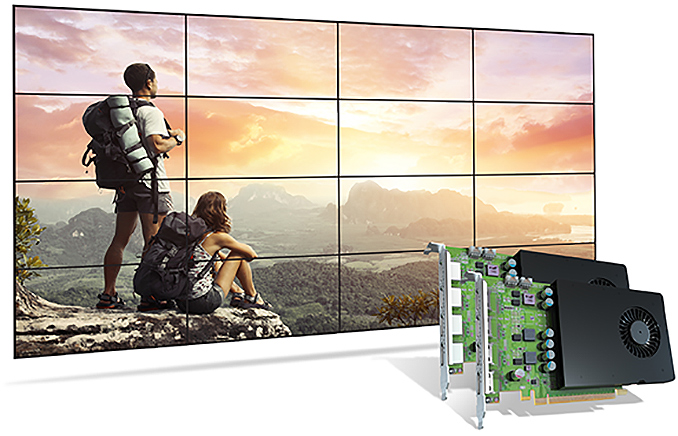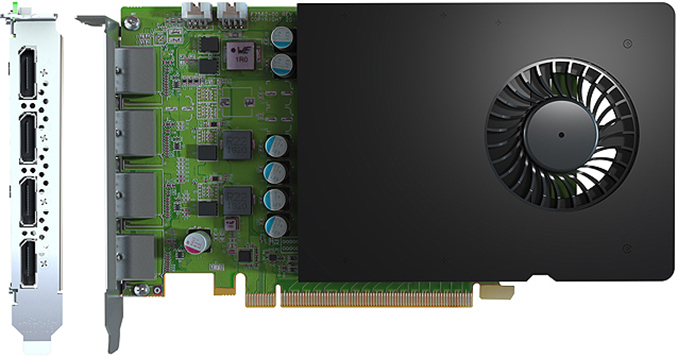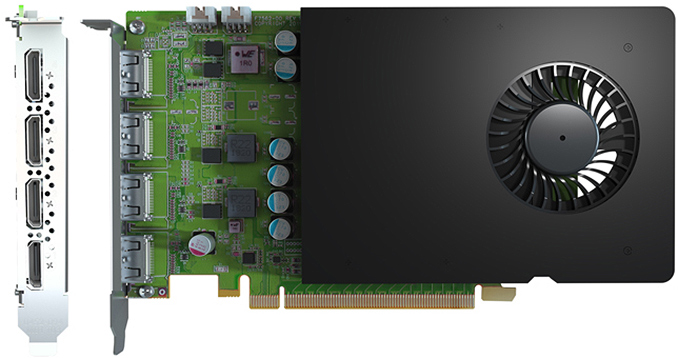Matrox Unveils D-Series Graphics Cards with NVIDIA Quadro GPUs
by Anton Shilov on January 29, 2020 2:30 PM EST
Matrox Graphics is one of the oldest graphics card manufacturers still in business today. It started to make video cards in 1978, several years before ATI, and 15 years before NVIDIA. While the company's own internal GPU development efforts petered early this century, the company has continued on as a specialist card maker, using other vendors' GPUs to make special-purpose multi-monitor solutions. Since 2014 the company has been using AMD’s GPUs for its boards, and earlier this month the company inked a similar agreement with NVIDIA. This week, Matrox launched its first NVIDIA-based graphics cards.
The Matrox D-series family of multi-display graphics cards based on a custom-built NVIDIA Quadro embedded GPU and carries 4 GB of GDDR5 memory as well as four DisplayPort 1.4 (D1480) or four HDMI 2.0 (D1450) outputs. The D1450 supports four monitors, with a maximum resolution of up to 4096x2160@60Hz, whereas the D1480 adapter supports four monitors with resolujtions up to 5120×3200@60Hz. The card consumes 47 W and only uses power supplied to it through the PCIe x16 slot.
For video wall applications used in aerospace, military, pro A/V, digital signage, security, and industries, four of Matrox D-series boards can be combined in a single system via board-to-board framelock cables, driving up to 16 displays using one PC. In addition, the cards can further be augmented with Matrox's QuadHead2Go multi-display controllers to drive up to 64 Full-HD screens from a single PC. It is also possible to pair D-series cards with Matrox Mura IPX capture and IP encode/decode boards for applications that need those capabilities.
Matrox does not disclose which GPU it uses for the D-series video cards, but it claims that the ‘custom-built’ NVIDIA Quadro GPU is compatible with DirectX 12, OpenCL 1.2 and OpenGL 4.5, which points to one of NVIDIA’s latest architecture (e.g., Pascal, Turing).
Matrox’s D1450 and D1480 graphics cards will be available sometimes in the second quarter. Their exact pricing is unknown, but expect to see Matrox to charge a premium for their specialized products.
Related Reading:
- Matrox Acquired by Co-Founder
- Matrox to Use AMD GPUs in Their Next Generation Multi-Display Graphics Cards
Sources: Matrox Graphics, Matrox Graphics












29 Comments
View All Comments
mode_13h - Tuesday, February 4, 2020 - link
Matrox Millennium were awesome 2D cards.fazalmajid - Thursday, January 30, 2020 - link
They couldn't keep up with nVidia and ATI in 3D performance, but they used to be the card of choice for graphics artists because they used higher quality RAMDACs in their cards, which made for better image quality on VGA connections.It looks like the co-founder Lorne Trottier bought back full ownership of the company. There are two underserved niches he could invest in: video cards with built-in KVM and VNC support for servers, and systems to support full-sized video walls for the coming generation of full-wall OLED and MiniLED displays inside homes (think the original Total Recall movie).
Jon Tseng - Thursday, January 30, 2020 - link
When I worked in a big bank I seem to remember the big boxes on the trading floor had Matrox display cards - they were targeting enterprise market for multi-monitor (say 4-6 screen) set-ups. Presumably this is similar to technically to video wall stuff..mode_13h - Wednesday, February 5, 2020 - link
https://en.wikipedia.org/wiki/Tseng_Labsbourbononthebow - Thursday, January 30, 2020 - link
so they're re-badged Quadro P2000s with worse drivers. Great.jydurocher - Thursday, January 30, 2020 - link
I'm partial here and I will thread gently to avoid breaching a couple of NDA's.I bought the first (as in 1) video editing from Matrox in the early 1990's. It worked as all .80 software based system at the edge of their niche, in this case Linear Editor worked: Excellent when it did.
It was a National Film Board request, aimed at the CBC that for reasons unknown prefered an USA solution costing 3-5 times as much. Then, it was hard to justify a 50K$ technician working on a 25K$ cube.
Then came the absurdity of Quebec politics. Lorne steppep into the 95 referendum and the company became an outcast. During that period due to pure stupidity, Quebec lost the edge it had in graphics, Matrox, sound card Adlib and a couple smaller players.
Then the two founders warred between them and the well known Quebec model of having the government get between the beligerents and brokered a peace treaty wsa not apply.
But while it abandonned hardware, Quebec won big on the video game industry. We could have done both,
Guspaz - Monday, February 3, 2020 - link
The failure of the Matrox Parhelia had nothing to do with Quebec politics and everything to do with Matrox making poor decisions and poor management. At least I assume Matrox Graphics was as dysfunctional as Matrox Imaging was when I worked there.mode_13h - Tuesday, February 4, 2020 - link
Damn. Adlib was Canadian? I didn't know that.I think all I remember of Adlib was that most Sound Blaster cards had Adlib compatibility. I guess Adlib was a bit before my time (I think it was FM Synthesis-only - no PCM?).
mode_13h - Tuesday, February 4, 2020 - link
Nvidia already seems to have a range of establish solutions addressing video wall applications:https://www.nvidia.com/en-us/design-visualization/...
https://www.nvidia.com/en-us/design-visualization/...
https://www.nvidia.com/en-us/design-visualization/...
Exactly how is Matrox going to compete?